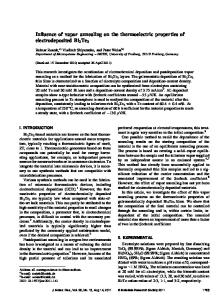Thermoelectric Properties of Tl 2 Te-Sb 2 Te 3 Pseudo-Binary System
- PDF / 227,240 Bytes
- 6 Pages / 612 x 792 pts (letter) Page_size
- 39 Downloads / 450 Views
0886-F08-03.1
Thermoelectric Properties of Tl2Te-Sb2Te3 Pseudo-Binary System Ken Kurosaki, Keita Goto, Atsuko Kosuga, Hiroaki Muta, and Shinsuke Yamanaka Division of Sustainable Energy and Environmental Engineering, Graduate School of Engineering, Osaka University, Yamadaoka 2-1, Suita, Osaka 565-0871, Japan ABSTRACT Polycrystalline-sintered samples of thallium based substances, (Tl2Te)100-x(Sb2Te3)x (x= 0, 1, 5, 10), were prepared by melting Tl2Te and Sb2Te3 ingots followed by annealing in sealed quartz ampoules. The thermoelectric properties were measured from room temperature to around 600 K. The values of the Seebeck coefficient of all samples are positive, indicating a p-type conduction characteristic. The maximum value of the power factor is 6.53x10-4 Wm-1K-2 at 591 K obtained for x= 10 (Tl9SbTe6), which is about one order lower than those of state-of-the-art thermoelectric materials. All samples indicate an extremely low thermal conductivity, for example that of Tl2Te is approximately 0.35 Wm-1K-1 from room temperature to around 600 K. Although the electrical performance of the samples is not so good, the ZT value is relatively high due to the extremely low thermal conductivity. The maximum ZT value is 0.42 at 591 K obtained for Tl9SbTe6.
INTRODUCTION Thallium compounds have attracted considerable attention as new thermoelectric materials because of their very low thermal conductivity [1-3]. To develop high-performance bulk thermoelectric materials, we are currently exploring ternary thallium tellurides. In our group, we have studied the thermoelectric properties of AgTlTe [4], Ag9TlTe5 [5], CuTl9Te5 [6], Tl9BiTe6 [7], TlSbTe2 [8] and so on. The values of the dimensionless figure of merit (ZT) of these compounds are relatively high; especially that of Ag9TlTe5 is 1.23 at 700 K. The greatest characteristic of the thallium compounds is their extremely low thermal conductivity. For example, the values of the thermal conductivity of AgTlTe, Ag9TlTe5 and Tl2Te at around room temperature are 0.25, 0.22 and 0.35 Wm-1K-1, respectively. These values are approximately one-fifth or one-sixth of the value for current state-of-the-art thermoelectric materials such as Bi2Te3. On the other hand, some researchers have reported the phase equilibria for the Tl2Te-Sb2Te3 pseudo binary system [9]. In this study, we examine the thermoelectric properties
0886-F08-03.2
of Tl2Te-Sb2Te3 pseudo binary system, in which Sb2Te3 content is up to 10 mol. %; that is (Tl2Te)100-x(Sb2Te3)x (x= 0, 1, 5, 10). The electrical resistivity, Seebeck coefficient and thermal conductivity of the materials were measured and the effect of Sb2Te3 content on the properties was studied.
EXPERIMENT The polycrystalline samples were prepared by a standard solid-state reaction. The appropriate amounts of starting materials (Tl2Te and Sb2Te3 ingots, both supplied by Furuuchi Chemical Co., Ltd.) were sealed in silica tubes and melted at 1173 K for two hours followed by annealing at 723 K for 7 days. The obtained samples were crushed to powders and the powde
Data Loading...










